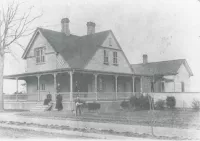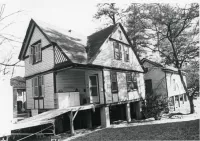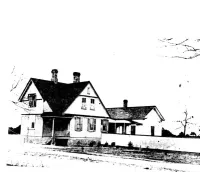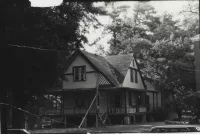Share what you know,
and discover more.
Share what you know,
and discover more.
Nov 29, 1979
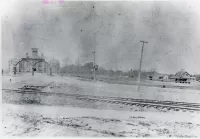
-

- Charmaine Bantugan
National Register of Historic Places - Pegram House (Faculty Avenue Houses TR )
Statement of Significance: Among the faculty members and their families who moved with Trinity College to Durham was that of Professor W. H. Pegram, who was during a fifty-five-year association with the college a student, professor and professor emeritus. He was a prime mover in the development of the Chemistry and Physics Departments. Pegram Dormitory on Duke's East Campus is named in his honor. William Howell Pegram, born August 18, 1846 at Chalk Level in Harnett County, North Carolina, as a youth fought for fifteen months during the Civil War under Generals Robert E. Lee and Stonewall Jackson and acquired an erect military carriage which was to remain with him all his life. He is remembered as a "lean, erect, austere figure with a long white beard."11 "The Alumni register reports neither the battlefield nor the prison camp warped his high purpose nor made him sordid; he came forth from the conflict determined to make some contribution to the rehabilitation of his native State and steadfastly set his face toward the future, without compromise. He returned to his home and began immediately to prepare himself for college."12 He entered Trinity College, January, 1869 and "within a few brief months he had firmly establish- ed himself as a student and leader." As an undergraduate he often assisted in the teaching of science and English literature. A graduate of the class of '73. A. M., Tutor of Natural Science. "The following year he became Professor of Natural Science and set about to develop, with limited resources, a department of science that was the forerunner of the present Departments of Chemistry, Biology, Physics, and Engineering."14 According to an un gned history of the Physics Department, c.1905. "In 1873 a bright young man, just out of college and full of the fine enthusiasm of youth was appointed to teach the sciences. It did not take him long to doff his coat, roll up his sleeves and resolve to make something happen. This youth was William H. Pegram. The records do not show whether this fine enthusiasm was fundamentally excited by a love of pure science or by a love of the President's daughter. The fact is well established, however, that through it he won the unqualified approval of the President and also of the President's daughter, and thereby won for himself a career in science." Rev. Craven Pegram married Emma, the daughter of Rev. Braxton Craven, on June 10, 1875. served as President of Trinity College, Randolph County and Pegram himself served as interim President for seven months after Craven's death in 1882. Prof. and Mrs. Pegram's five sons and daughters are graduates of Trinity College and daughter Annie had the distinction of becoming the first woman to enroll in Trinity College, Durham, in 1892. She was to become a member of the faculty of Greensboro College and the last Pegram to live in the Faculty Row house until her death in the 1960's. Professor Pegram taught English for several years after 1879. It was not until 1900 that the "resources of the institution where such as to permit him to confine his teaching to Chemistry, the branch of science that held his especial interest."16 He also coached the debate team for many years and "generations of students received their training in the mechanics of public speaking under Prof. Pegram." In 1917 the L.L.D. degree was conferred on him and he was named Professor Emeritus of Chemistry in 1919 and was relieved of any regular teaching duties, "but was free to come and go about the campus at will giving advice and counsel whenever and wherever needed. " Called "one of the most beloved men who ever served the institution, "19 he was a charter member of Trinity College's chapter of Phi Beta Kappa and was an active member of Trinity Methodist Episcopal Church South. He died at home, April 30, 1928. In his obituary in the "Alumni Register" a conversation between Washington Duke, wealthy founder of the American Tobacco Company and the modestly salaried Professor is reported. Washington Duke outlined his career's progress to Pegram who countered with: "After my Civil War experience, I spent four years on my father's farm and then four years in Trinity College, graduated 1873, was called the same year to the chair of Natural Science in said College and have been with it ever since. From this last statement you know my financial rating.' (Duke) saw the point and countered with 'Yes, but you have made something better than money; you have helped to make men. " As the campus expanded, the Faculty Houses were moved across the street and scattered within Trinity Park. The Pegram House moved to a lot apparently owned by Pegram at 308 Buchanan Boulevard, (then Guess Mill Road). In a letter to his father dated March 18, 1916, George Pegram wrote: "Since hearing that you have to move your house, I have been wondering how much it is going to cost and how much I may be able to help out on the expense. I should think the college ought to do the moving or at least bear a good part of the expense, since putting professors out of their houses is really cutting their salaries down. If I remember rightly you have two lots on Guess Street (sic) one of them unencumbered and I suppose you will move the house on to that one, but I have only a very vague idea of what it might cost We are perhaps in less stringent financial circumstances with our house than last year, which moves me to hope to be of at least a little assistance to you. " The cost of the move is not recorded, but it is known that the move "was accomplished by placing the house on logs and pulling it with a team of horses."22 Elizabeth Lyon a long time Durham resident remembers watching the move from her upstairs bedroom window. George Pegram wrote again to his father concerning the move on September 7, 1916: "I wonder how your house moving progressed. Charles Edwards, I believe it was, told me that the dining room and kitchen had already gone, but that you did not expect to move the house proper until some weeks later. You have probably taken a pleasure in seeing that the new foundations are at least as good as the old ones, so as to obviate somewhat the cracking tendency the house always had." The house remained in the family until the death of the last of Pegram's unmarried children, Annie. On February 20, 1962 she transferred via trust the house to NCNB. Following a suit filed by Greensboro College against NCNB, executor for Annie Pegram was sold at public auction on November 22, 1966 for $11,500 to Frances G. Crabtree. She, in turn, sold it to Herndon Building Company, April 3, 1969 for $10 subject to a $10,000 note to Home Savings & Loan. 27 Threatened with demolition to make way for a parking lot for an apartment building Mr. Fred Herndon owned next door, he offered to move the house at his own expense and make it available to a citizen's group. The Durham Historic Preservation Society bought it and the 3,120 sq. ft. house was moved again in September, 1977. This move to 1019 Minerva Ave. took six days and was plagued with troubles. "After being jacked up onto the truck for the move, the back end fell off. Other problems included a broken drive shaft and axle in the truck and ensnarement by a tree."28 The "Durham Morning Herald" of September 27, 1977 reports that "after much backing and twisting, "by a fraction of an inch, the house turned onto Buchanan Boulevard to a round of applause by the spectators. Even at the intersection of Watts St. and Minerva, the move appeared to be going well. But then the axle broke dumping the house precariously to one side. "
National Register of Historic Places - Pegram House (Faculty Avenue Houses TR )
Statement of Significance: Among the faculty members and their families who moved with Trinity College to Durham was that of Professor W. H. Pegram, who was during a fifty-five-year association with the college a student, professor and professor emeritus. He was a prime mover in the development of the Chemistry and Physics Departments. Pegram Dormitory on Duke's East Campus is named in his honor. William Howell Pegram, born August 18, 1846 at Chalk Level in Harnett County, North Carolina, as a youth fought for fifteen months during the Civil War under Generals Robert E. Lee and Stonewall Jackson and acquired an erect military carriage which was to remain with him all his life. He is remembered as a "lean, erect, austere figure with a long white beard."11 "The Alumni register reports neither the battlefield nor the prison camp warped his high purpose nor made him sordid; he came forth from the conflict determined to make some contribution to the rehabilitation of his native State and steadfastly set his face toward the future, without compromise. He returned to his home and began immediately to prepare himself for college."12 He entered Trinity College, January, 1869 and "within a few brief months he had firmly establish- ed himself as a student and leader." As an undergraduate he often assisted in the teaching of science and English literature. A graduate of the class of '73. A. M., Tutor of Natural Science. "The following year he became Professor of Natural Science and set about to develop, with limited resources, a department of science that was the forerunner of the present Departments of Chemistry, Biology, Physics, and Engineering."14 According to an un gned history of the Physics Department, c.1905. "In 1873 a bright young man, just out of college and full of the fine enthusiasm of youth was appointed to teach the sciences. It did not take him long to doff his coat, roll up his sleeves and resolve to make something happen. This youth was William H. Pegram. The records do not show whether this fine enthusiasm was fundamentally excited by a love of pure science or by a love of the President's daughter. The fact is well established, however, that through it he won the unqualified approval of the President and also of the President's daughter, and thereby won for himself a career in science." Rev. Craven Pegram married Emma, the daughter of Rev. Braxton Craven, on June 10, 1875. served as President of Trinity College, Randolph County and Pegram himself served as interim President for seven months after Craven's death in 1882. Prof. and Mrs. Pegram's five sons and daughters are graduates of Trinity College and daughter Annie had the distinction of becoming the first woman to enroll in Trinity College, Durham, in 1892. She was to become a member of the faculty of Greensboro College and the last Pegram to live in the Faculty Row house until her death in the 1960's. Professor Pegram taught English for several years after 1879. It was not until 1900 that the "resources of the institution where such as to permit him to confine his teaching to Chemistry, the branch of science that held his especial interest."16 He also coached the debate team for many years and "generations of students received their training in the mechanics of public speaking under Prof. Pegram." In 1917 the L.L.D. degree was conferred on him and he was named Professor Emeritus of Chemistry in 1919 and was relieved of any regular teaching duties, "but was free to come and go about the campus at will giving advice and counsel whenever and wherever needed. " Called "one of the most beloved men who ever served the institution, "19 he was a charter member of Trinity College's chapter of Phi Beta Kappa and was an active member of Trinity Methodist Episcopal Church South. He died at home, April 30, 1928. In his obituary in the "Alumni Register" a conversation between Washington Duke, wealthy founder of the American Tobacco Company and the modestly salaried Professor is reported. Washington Duke outlined his career's progress to Pegram who countered with: "After my Civil War experience, I spent four years on my father's farm and then four years in Trinity College, graduated 1873, was called the same year to the chair of Natural Science in said College and have been with it ever since. From this last statement you know my financial rating.' (Duke) saw the point and countered with 'Yes, but you have made something better than money; you have helped to make men. " As the campus expanded, the Faculty Houses were moved across the street and scattered within Trinity Park. The Pegram House moved to a lot apparently owned by Pegram at 308 Buchanan Boulevard, (then Guess Mill Road). In a letter to his father dated March 18, 1916, George Pegram wrote: "Since hearing that you have to move your house, I have been wondering how much it is going to cost and how much I may be able to help out on the expense. I should think the college ought to do the moving or at least bear a good part of the expense, since putting professors out of their houses is really cutting their salaries down. If I remember rightly you have two lots on Guess Street (sic) one of them unencumbered and I suppose you will move the house on to that one, but I have only a very vague idea of what it might cost We are perhaps in less stringent financial circumstances with our house than last year, which moves me to hope to be of at least a little assistance to you. " The cost of the move is not recorded, but it is known that the move "was accomplished by placing the house on logs and pulling it with a team of horses."22 Elizabeth Lyon a long time Durham resident remembers watching the move from her upstairs bedroom window. George Pegram wrote again to his father concerning the move on September 7, 1916: "I wonder how your house moving progressed. Charles Edwards, I believe it was, told me that the dining room and kitchen had already gone, but that you did not expect to move the house proper until some weeks later. You have probably taken a pleasure in seeing that the new foundations are at least as good as the old ones, so as to obviate somewhat the cracking tendency the house always had." The house remained in the family until the death of the last of Pegram's unmarried children, Annie. On February 20, 1962 she transferred via trust the house to NCNB. Following a suit filed by Greensboro College against NCNB, executor for Annie Pegram was sold at public auction on November 22, 1966 for $11,500 to Frances G. Crabtree. She, in turn, sold it to Herndon Building Company, April 3, 1969 for $10 subject to a $10,000 note to Home Savings & Loan. 27 Threatened with demolition to make way for a parking lot for an apartment building Mr. Fred Herndon owned next door, he offered to move the house at his own expense and make it available to a citizen's group. The Durham Historic Preservation Society bought it and the 3,120 sq. ft. house was moved again in September, 1977. This move to 1019 Minerva Ave. took six days and was plagued with troubles. "After being jacked up onto the truck for the move, the back end fell off. Other problems included a broken drive shaft and axle in the truck and ensnarement by a tree."28 The "Durham Morning Herald" of September 27, 1977 reports that "after much backing and twisting, "by a fraction of an inch, the house turned onto Buchanan Boulevard to a round of applause by the spectators. Even at the intersection of Watts St. and Minerva, the move appeared to be going well. But then the axle broke dumping the house precariously to one side. "
Nov 29, 1979
National Register of Historic Places - Pegram House (Faculty Avenue Houses TR )
Statement of Significance:Among the faculty members and their families who moved with Trinity College to Durham was that of Professor W. H. Pegram, who was during a fifty-five-year association with the college a student, professor and professor emeritus. He was a prime mover in the development of the Chemistry and Physics Departments. Pegram Dormitory on Duke's East Campus is named in his honor.
William Howell Pegram, born August 18, 1846 at Chalk Level in Harnett County, North Carolina, as a youth fought for fifteen months during the Civil War under Generals Robert E. Lee and Stonewall Jackson and acquired an erect military carriage which was to remain with him all his life. He is remembered as a "lean, erect, austere figure with a long white beard."11 "The Alumni register reports neither the battlefield nor the prison camp warped his high purpose nor made him sordid; he came forth from the conflict determined to make some contribution to the rehabilitation of his native State and steadfastly set his face toward the future, without compromise. He returned to his home and began immediately to prepare himself for college."12 He entered Trinity College, January, 1869 and "within a few brief months he had firmly establish- ed himself as a student and leader."
As an undergraduate he often assisted in the teaching of science and English literature. A graduate of the class of '73. A. M., Tutor of Natural Science. "The following year he became Professor of Natural Science and set about to develop, with limited resources, a department of science that was the forerunner of the present Departments of Chemistry, Biology, Physics, and Engineering."14 According to an un gned history of the Physics Department, c.1905.
"In 1873 a bright young man, just out of college and full of the fine enthusiasm of youth was appointed to teach the sciences. It did not take him long to doff his coat, roll up his sleeves and resolve to make something happen. This youth was William H. Pegram. The records do not show whether this fine enthusiasm was fundamentally excited by a love of pure science or by a love of the President's daughter. The fact is well established, however, that through it he won the unqualified approval of the President and also of the President's daughter, and thereby won for himself a career in science."
Rev. Craven Pegram married Emma, the daughter of Rev. Braxton Craven, on June 10, 1875. served as President of Trinity College, Randolph County and Pegram himself served as interim President for seven months after Craven's death in 1882. Prof. and Mrs. Pegram's five sons and daughters are graduates of Trinity College and daughter Annie had the distinction of becoming the first woman to enroll in Trinity College, Durham, in 1892. She was to become a member of the faculty of Greensboro College and the last Pegram to live in the Faculty Row house until her death in the 1960's.
Professor Pegram taught English for several years after 1879. It was not until 1900 that the "resources of the institution where such as to permit him to confine his teaching to Chemistry, the branch of science that held his especial interest."16 He also coached the debate team for many years and "generations of students received their training in the mechanics of public speaking under Prof. Pegram." In 1917 the L.L.D. degree was conferred on him and he was named Professor Emeritus of Chemistry in 1919 and was relieved of any regular teaching duties, "but was free to come and go about the campus at will giving advice and counsel whenever and wherever needed. "
Called "one of the most beloved men who ever served the institution, "19 he was a charter member of Trinity College's chapter of Phi Beta Kappa and was an active member of Trinity Methodist Episcopal Church South. He died at home, April 30, 1928. In his obituary in the "Alumni Register" a conversation between Washington Duke, wealthy founder of the American Tobacco Company and the modestly salaried Professor is reported. Washington Duke outlined his career's progress to Pegram who countered with: "After my Civil War experience, I spent four years on my father's farm and then four years in Trinity College, graduated 1873, was called the same year to the chair of Natural Science in said College and have been with it ever since. From this last statement you know my financial rating.' (Duke) saw the point and countered with 'Yes, but you have made something better than money; you have helped to make men. "
As the campus expanded, the Faculty Houses were moved across the street and scattered within Trinity Park. The Pegram House moved to a lot apparently owned by Pegram at 308 Buchanan Boulevard, (then Guess Mill Road). In a letter to his father dated March 18, 1916, George Pegram wrote:
"Since hearing that you have to move your house, I have been wondering how much it is going to cost and how much I may be able to help out on the expense. I should think the college ought to do the moving or at least bear a good part of the expense, since putting professors out of their houses is really cutting their salaries down. If I remember rightly you have two lots on Guess Street (sic) one of them unencumbered and I suppose you will move the house on to that one, but I have only a very vague idea of what it might cost We are perhaps in less stringent financial circumstances with our house than last year, which moves me to hope to be of at least a little assistance to you. "
The cost of the move is not recorded, but it is known that the move "was accomplished by placing the house on logs and pulling it with a team of horses."22 Elizabeth Lyon a long time Durham resident remembers watching the move from her upstairs bedroom window.
George Pegram wrote again to his father concerning the move on September 7, 1916:
"I wonder how your house moving progressed. Charles Edwards, I believe it was, told me that the dining room and kitchen had already gone, but that you did not expect to move the house proper until some weeks later. You have probably taken a pleasure in seeing that the new foundations are at least as good as the old ones, so as to obviate somewhat the cracking tendency the house always had."
The house remained in the family until the death of the last of Pegram's unmarried children, Annie. On February 20, 1962 she transferred via trust the house to NCNB. Following a suit filed by Greensboro College against NCNB, executor for Annie Pegram was sold at public auction on November 22, 1966 for $11,500 to Frances G. Crabtree. She, in turn, sold it to Herndon Building Company, April 3, 1969 for $10 subject to a $10,000 note to Home Savings & Loan. 27 Threatened with demolition to make way for a parking lot for an apartment building Mr. Fred Herndon owned next door, he offered to move the house at his own expense and make it available to a citizen's group. The Durham Historic Preservation Society bought it and the 3,120 sq. ft. house was moved again in September, 1977.
This move to 1019 Minerva Ave. took six days and was plagued with troubles. "After being jacked up onto the truck for the move, the back end fell off. Other problems included a broken drive shaft and axle in the truck and ensnarement by a tree."28 The "Durham Morning Herald" of September 27, 1977 reports that "after much backing and twisting, "by a fraction of an inch, the house turned onto Buchanan Boulevard to a round of applause by the spectators. Even at the intersection of Watts St. and Minerva, the move appeared to be going well. But then the axle broke dumping the house precariously to one side. "
Posted Date
Aug 29, 2023
Historical Record Date
Nov 29, 1979
Source Name
National Register of Historic Places
Source Website
Delete Story
Are you sure you want to delete this story?


